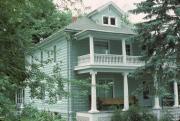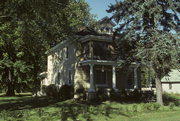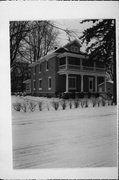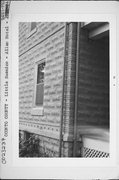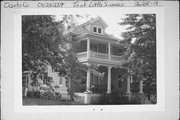Property Record
1117 GROSSE ST
Architecture and History Inventory
| Historic Name: | GEORGE ALLEN HOTEL |
|---|---|
| Other Name: | |
| Contributing: | |
| Reference Number: | 23237 |
| Location (Address): | 1117 GROSSE ST |
|---|---|
| County: | Oconto |
| City: | |
| Township/Village: | Little Suamico |
| Unincorporated Community: | LITTLE SUMIACO |
| Town: | 26 |
| Range: | 21 |
| Direction: | E |
| Section: | 19 |
| Quarter Section: | NE |
| Quarter/Quarter Section: | SE |
| Year Built: | 1910 |
|---|---|
| Additions: | |
| Survey Date: | 1999 |
| Historic Use: | hotel/motel |
| Architectural Style: | Colonial Revival/Georgian Revival |
| Structural System: | |
| Wall Material: | Rock-Faced Concrete Block |
| Architect: | |
| Other Buildings On Site: | |
| Demolished?: | No |
| Demolished Date: |
| National/State Register Listing Name: | Not listed |
|---|---|
| National Register Listing Date: | |
| State Register Listing Date: |
| Additional Information: | A 'site file' exists for this property. It contains additional information such as correspondence, newspaper clippings, or historical information. It is a public record and may be viewed in person at the Wisconsin Historical Society, State Historic Preservation Office. 2 TIERED PORCH W/FLUTED IONIC COLUMNS & PLAIN DORIC COLUMNS. COBBLESTONE TEXTURED CONRETE BLOCK CNR QUOINS. TEXTURED CONCRETE BLOCK BELT COURSES. WINDOWS W/LEADED GLASS TRANSOMS. CONCRETE SILLS AND LINTELS. The home of a rural mail carrier and his wife, the Allen House is distinguished by the variety of styles of concrete blocks that fashion its walls. Concrete block became a popular building material after Harmon S. Palmer patented a block-making machine in 1900. After 1905, anyone could go into business making blocks, using a machine from Sears, Roebuck and Company. The builder poured concrete into the mold and tamped it to eliminate air bubbles. After taking it out of the mold, he then set it on a pallet to cure for several weeks. Although the machine made only one block at a time, two men working together could produce as many as one hundred blocks per day. The Allen House showcases the great variety of textures the block-maker could create simply by changing the face plate in the mold. The most popular surface-texture was the rock faced block, meant to simulate stone, although the cookie-cutter sameness of the concrete blocks fooled no one. In the Allen House, rock-faced blocks laid with beaded mortar joints form the main segments of the walls, giving them a solid formality. But smaller details make the building stand out. A line of concrete buttons, two per smooth-faced block, forms a border along a concrete cap marking the top of the slightly raised basement, and a course of closely spaced beads divides the first floor from the second. Triple rows of nailhead molding ornament the blocks at the corners. These classic block patterns lent themselves well to the house’s Colonial Revival design, characterized by a two-tiered portico and a hipped roof pierced by a pedimented dormer. The veranda features fluted Ionic columns, cast in concrete, on the first story and smooth Tuscan columns on the second. The Tuscan columns anchor a spindle balustrade, which wraps around the porch, forming a second-story balcony. |
|---|---|
| Bibliographic References: | Buildings of Wisconsin manuscript. |
| Wisconsin Architecture and History Inventory, State Historic Preservation Office, Wisconsin Historical Society, Madison, Wisconsin |

